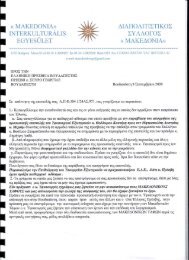Görög Örökség Ελληνική Κληρονομιά - H-ellin.com
Görög Örökség Ελληνική Κληρονομιά - H-ellin.com
Görög Örökség Ελληνική Κληρονομιά - H-ellin.com
Create successful ePaper yourself
Turn your PDF publications into a flip-book with our unique Google optimized e-Paper software.
etween 1754 and 1771 in the Danubian areas it appears that in Szentendre there were eight Greeks whereas<br />
in Csobanka and Pamaz there was one greek in each city.<br />
Concerning the Temple of Blagovesztenszka, Odon Fuves wrote the following: " The Greeks of Szentendre<br />
did not have their own temple although one of the seven orthodox temples, the Temple of Blagovesztensz built<br />
in 1752 was called a Greek Temple ever since the 18' century. We do not have any written evidence about the<br />
erection of the greek temple, either. Neither does the temple's interior indicates greek origin." Fuves explains<br />
that the name "greek temple" derives from the fact that the greek traders were living in the city centre where<br />
the church is, the building of which had apparently assisted with donations of big amounts. He also claims that<br />
as long as the Greek residents of Vac did not have their own church, they belonged here from the parish point<br />
of view. This is the reason why the Greek trader of Vac, Demeter Tolojani, who died in Szentendre was buried<br />
in the local temple. During the time of the conduct of Odon Fuves's study it was not yet revealed the evidence<br />
of a protocol of 1697 based on which, in our opinion we can claim with certainty that the Temple of<br />
Blagovesztenszka "inherited" the name of its ancestor. We sustain that during the time that the Greeks settled,<br />
their number was big enough to <strong>com</strong>pose a separate <strong>com</strong>munity. Their number probably decreased later on<br />
resulting in them not needing their own temple. Perhaps the destiny of the Greeks of Szentendre was moving<br />
or being accumulated by the Serbian <strong>com</strong>munity, which is verified by the fate of the Tyro and Dumcsa<br />
families.<br />
The road next to the church might have been the "road that leads to the Danube". The name of the street today<br />
is "Gorog street" ( Street of the Greeks). The Serbian Museum of Church Art exhibits icons with greek<br />
inscriptions that were taken there from other temples of Szentendre.<br />
Tokaj<br />
The settlement of the Greeks in Upper Hungary and later in Rizovounia, mainly in Tokaj, occurred in three<br />
progressive, strongly related steps. Since the middle of the 17 1 century in Kassa (Kositse) the Greeks had<br />
be<strong>com</strong>e tough trading opponents, which is proven by the numerous notes in the protocols and restriction books<br />
of the city. Since 1660 the business activities of the following Greek traders is known: Demeter Gorog, István<br />
Gorog, Peter Gorog, János Karácsonyi and Tamás Karácsonyi. The previously mentioned Greeks ( who first<br />
wished to settle in Kositse) during the last third of the 1Τ century lived mainly in Tokaj. From the members of<br />
the Gorog family, the son of István Gorog, Demeter Gorog was already a taxpayer in Tokaj in the years 1673-<br />
92. In August 1660 the Turkish occupied Orantea. The Greek traders of the city were forced to create new<br />
business areas and centres. Some might have been found in Rizovounia at that time. There were two essential<br />
business roads to Polland: one after Orantea and Tokaj crossed through Tarcal, Mad, Tallya, Szanto, Vizsoly (<br />
alley of the river Hernád), Hidasnémeti, Kositse whereas the other one crossed the settlements of Tokaj,<br />
Bodrogkeresztur, Olaszliszka, Sárospatak, Sátoraljaújhely<br />
The third part of settlement relates primarily to the destiny of the Greek trading group of Debrecen. On 19 1<br />
May 1690 (L.RXX. 372.) a royal privilege was given to the Greek traders of Debrecen which was issued after<br />
the claim of the Greek superior official (fobiro) of Debrecen, Marton Horváth and the Greek trader Sándor<br />
Hunyadi. We sustain that the latter relates to Sándor Karacsony/Karatsonyi who was the most important Greek<br />
business transporter of Ferenc Rákóczi Β' during the period of the war for liberation (a part of his family had<br />
been present in Tokaj for at least three decades.). Within the frame of the feudal society it was of great<br />
importance the privilege of the Greeks of Debrecen: the king offered the group an escutcheon (in the green<br />
valley of the blue escutcheon a sheep is grazing turned to the right, on top of it there is an eagle with its wings<br />
open and with its head turned to the right it is holding a green plant with its beak). In 1693 Debrecen obtained<br />
the state of the free royal city and the Greek trading group had to abandon the city. New business centers for<br />
these Greek traders became Szatmar and Németi. In 1705 ( after conquering the castle of Szatmar) the ruler<br />
Ferenc Rákóczi B' decided to settle the Greeks of Németi in Tokaj, since that was the place were the property<br />
of the Rakoczi family was.<br />
The ruler Ferenc Rakoczi B' wished to create the most important business wine center in Tokaj. He was<br />
expecting the activities of the Greek traders to have the same business growth that his ancestors had<br />
experienced in Transylvania. In 1708 also the Greeks who were living until then in Debrecen found new<br />
dw<strong>ellin</strong>gs in Tokaj. All these decisions for the settlement of the Greeks were part of a pre-arranged financial<br />
strategy. Rakoczi did not neglect the vineyards that belonged to his family in Rizovounia not even during the<br />
war for freedom which<br />
69




